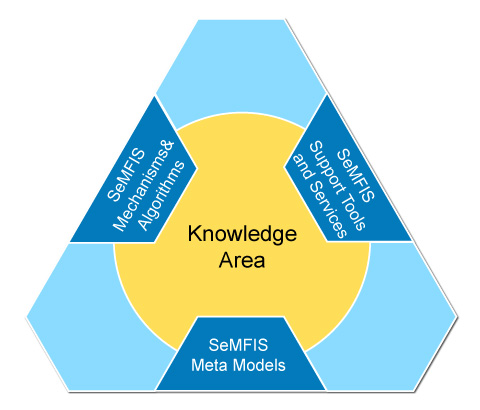Details
The Approach of SeMFIS
The aim of SeMFIS (Semantic-based Modeling Framework for Information Systems) is to semantically enrich conceptual models by providing a set of meta models, tools and mechanisms and algorithms. The framework is characterized by an adaptive approach to allow for the application to arbitrary types of conceptual models with no or very little configuration effort. To take into account all relevant aspects in the course of the design and implementation of information systems the framework is based on the concept of knowledge areas. With this concept different kinds of domains that make use of conceptual models for information systems are described. The goal of the framework is to allow for the processing of semantics in these models. To achieve this, the first conception of the framework contains three components that are related to each other: SeMFIS Meta Models, SeMFIS Support Tools and Services, and SeMFIS Mechanisms and Algorithms.

First Conception of the SeMFIS Framework
SeMFIS Meta Models
SeMFIS Meta Models are different from the meta models used for the knowledge area in the way that they shall provide means to deal with machine processable semantics that can be linked to the meta models of the knowledge area in order to allow for the machine processing of their semantics. In this aspect, the framework aims to eliminate a shortcoming of other approaches in the context of semantic enrichment of conceptual models: As the approach is also based on meta models, a coherent approach for dealing with meta models on the different levels of information systems as well as the machine processable semantics can be realized. Concerning the later implementation of the meta models, this allows to re-use the same functionality and mechanisms for conceptual and SeMFIS models, e.g. in regard to the visualization of the models, for the provision of analysis and search functionalities or for the storage and change management of the models. Furthermore, the users of the framework are not required to switch between different environments and methodologies for modeling and the handling of
semantics.
SeMFIS Support Tools and Services
SeMFIS Support Tools and Services shall be used to integrate specific tools and services for dealing with semantics into the SeMFIS framework. This concerns in particular tools for creating, manipulating, processing, and storing ontologies, e.g. Protégé, which can be used to provide functionality to the SeMFIS framework that might otherwise need to be re-implemented. By providing linkages to the other components of the SeMFIS framework bi-directional interaction of the SeMFIS components and the support tools and services shall be established. Thereby the available knowledge in the form of these tools and services can be integrated in the framework as well as the knowledge contained in the SeMFIS framework be made available to third parties. Furthermore, the re-use of existing tools and services allows to achieve results in a shorter time.
SeMFIS Mechanisms and Algorithms
SeMFIS Mechanisms and Algorithms shall be designed for the application to SeMFIS Meta Models and meta models of the knowledge area for the purpose of semantic information processing. As the goal of the framework is to provide answers in regard to the machine processing of semantic information in conceptual models, this component is of critical importance. It shall allow to analyze end evaluate the semantic information in conceptual models and provide functionality that is specific
to the SeMFIS framework and is not available through the use of support tools or services. In particular, this concerns also the import and export of information to and from the SeMFIS framework and the monitoring and handling of changes in the framework. Depending on the concrete functionality, SeMFIS Mechanisms and Algorithms shall either be developed as specific
mechanisms and algorithms for the use with the SeMFIS meta models or as hybrid mechanisms and algorithms for the application to meta models of the knowledge area
For a first conception the knowledge area has been set to five levels of conceptual models based on the BPMS paradigm as described by (Karagiannis, 1995). Thereby, strategic, business, implementation, execution and performance evaluation models are included and serve as the basis for the explication of semantics.


